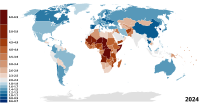
Photo from wikipedia
Fertility has become the most important biological factor in predicting population growth due to significant improvements in reducing mortality. Fertility projections are important in predicting the demand for water, food,… Click to show full abstract
Fertility has become the most important biological factor in predicting population growth due to significant improvements in reducing mortality. Fertility projections are important in predicting the demand for water, food, medical services and other basic social amenities. There are two main objectives in this study: 1) to examine past trends in age-specific fertility rate for West African countries; and 2) to predict future fertility rates there. Age-specific fertility data were retrieved from the United States Census Bureau; then simple linear regression models were fitted to forecast the fertility rates for seven age groups from 2016 to 2100. Results confirm that fertility rates in West Africa have been reducing very slowly as has been reported in other studies, but this examination reveals that few West African countries are likely to reach long-term fertility limits across all age groups due to the slow pace of reduction. This suggests that, current population control programs in most countries are not sufficient in achieving Sustainable Development Goals and policymakers need to consider additional measures to increase the pace of fertility reduction
Journal Title: Journal of Population and Social Studies
Year Published: 2018
Link to full text (if available)
Share on Social Media: Sign Up to like & get
recommendations!